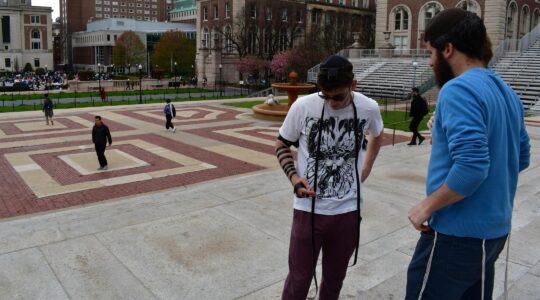SAN FRANCISCO (JTA) – Intermarriage: Disaster for the Jews, not great for the Jews, or simply a fact of Jewish life?
Ever since the 1990 National Jewish Population Study showed more than half of new Jewish marriages involve a non-Jewish partner, many Jewish communal leaders have latched onto the issue with pitbull tenacity – and they haven’t let go, even after the 2000-2001 NJPS showed intermarriage had leveled off.
Now a new round of studies is prompting more questions: Does intermarriage necessarily mean the end of that family’s connection to Judaism? Or is the Jewish community focusing on intermarriage to the exclusion of other, perhaps more telling, factors?
Most studies report the data in simple comparative fashion, which shows that intermarried families are much less Jewishly involved than inmarried families, from their beliefs to their practices.
But a provocative new study out of Brandeis University questions that research method and its conclusions.
The study – “It’s Not Just Who Stands Under the Chuppah: Jewish Identity and Intermarriage,” by Leonard Saxe, Fern Chertok and Benjamin Phillips of the Cohen Center for Jewish Studies and Steinhardt Social Research Institute – found that when one considers the Jewish background of the Jewish partner in an intermarriage, the difference in the Jewish beliefs and practices of inmarried and intermarried families becomes much less glaring.
And in some measures, like attachment to Israel, the gap almost disappears.
A second study casts further doubt on the deterministic effect of intermarriage. Set for release next month, the study by the Combined Jewish Philanthropies of Greater Boston will show that the children being raised Jewishly in the city’s intermarried families look pretty much like any other non-Orthodox Jewish children.
The “Chuppah” study only considered factors from before an intermarriage occurs, primarily the Jewish education and home practice of the Jewish partner. But its conclusions have profound policy implications: Instead of writing off intermarried families or pressing the non-Jewish partner to convert, the Jewish community would do better to invest in quality Jewish education – formal and informal – to give the Jewish partner in an intermarriage the background and desire to create a Jewish home and raise Jewish children.
“The objective doesn’t have to be conversion but the creation of positive, rich Jewish experiences,” Saxe explains. “Jewish education, Jewish home experiences, Jewish camp, Israeli experiences – that’s what leads to engagement in Jewish life whether one is intermarried or not.”
Saxe presented the study’s findings with Chertok on Dec. 14 at the Union for Reform Judaism biennial in San Diego.
“The usual model says you get intermarried and you lose your Jewish identity. That’s not true,” Chertok says. “A far more powerful predicter of what you’re going to do in your home are such things as did you have a Jewish education growing up? Were you raised with Jewish rituals in the home? What was your high school social network like?”
Chertok and Saxe drew the strongest audience reaction when they displayed two charts, one showing the Jewish involvement of intermarried vs. inmarried families without any controls, and one showing the results after they were controlled for the Jewish partner’s religious background.
Without controls, the inmarried family blew the intermarried family out of the mikveh: 78 percent of inmarried couples said they were raising their children Jewishly vs. 39 percent of intermarried couples. Those are the figures used by most Jewish researchers, Chertok and Saxe noted.
But when controlling the other factors, including the Jewish partner’s religious upbringing, the gap closed, with 71 percent of inmarried couples and 51 percent of couples saying they are raising Jewish children.
Similarly, the 53 percent of inmarried vs. 12 percent of intermarried families who reported being members of Jewish organizations became 45 percent and 32 percent when the controls were applied.
The differences become even more striking when controls are applied to the data on the Jewish identity of the adult children of intermarriage.
A simple comparison, one used in most studies, states that 89 percent of adults who grew up with two Jewish parents identify as Jewish vs. 24 percent of adults who grew up in an interfaith home.
When the background of those individuals was taken into account, the gap shrunk to 94 percent of the adults with two Jewish parents vs. 76 percent from intermarried homes.
“Intermarriage is not deterministic,” Saxe concluded. “If someone grows up with positive Jewish identity and Jewish educational experiences such as religious school, summer camp, Israel trips, one wants to raise Jewish children regardless of who one falls in love with.”
Among those who is not convinced by the Saxe-Chertok line of argument is Steven Cohen, a professor of Jewish social policy at Hebrew Union College-Jewish Institute of Religion in New York. Cohen has conducted several studies that all show the determinative effect of intermarriage.
Cohen’s first question is how the researchers defined “being raised Jewish.” But he also says they need to look at the second generation: According to the 2000-2001 NJPS study, just 13 percent of the grandchildren of an intermarriage – that is, people whose grandparents were intermarried – now identify as Jews.
On those grounds alone, Cohen declared, the Jewish community should “not grow complacent” about intermarriage but should continue to combat it as a real threat to Jewish continuity.
“In fact, intermarriage over two generations is more powerful than any other factor in predicting ritual observance and certainly in predicting whether the grandchildren will be Jewish,” he said.
Cohen’s conclusion is supported in part by a new report on the U.S. Jewish population prepared for the 2007 American Jewish Yearbook by Professors Ira Sheskin of the University of Miami and Arnold Dashefksy of the University of Connecticut.
Comparing data from 49 U.S. Jewish communities, Sheskin and Dashefsky note that while some cities “have been more successful than others in convincing intermarried families to raise their children Jewish,” it is nevertheless “clear that intermarriage has a negative effect on measures of Jewishness, and therefore on Jewish continuity.”
Intermarriage has a snowball effect, the Sheskin-Dashefsky study concludes, but the ball can roll either way, with much depending on the larger Jewish community.
Sheskin and Dashefsky just concluded a study in Portland, Maine, showing its intermarriage rate as the highest among the cities studied: 61 percent. But a very average 47 percent of its intermarried families are choosing to raise Jewish children. Yet in Detroit, with a low intermarriage rate of 17 percent, is combined with a relatively low number, 31 percent, choosing to raise children as Jews.
A community like Detroit’s, Sheskin posits, may not feel outreach is a priority given its low level of intermarriage. The result is that few intermarried families join synagogues, and when other intermarried families walk in, “They don’t see anyone that looks like them and they don’t feel comfortable.”
That’s where the Combined Jewish Philanthropies study comes into play.
Gil Preuss, vice president for strategy and planning, says the organization is less interested in debating research methods than in examining the real effect of community investment in outreach and Jewish education in Boston.
The CJP caused a stir iin November 2006 when it released a study by the Steinhardt institute showing that in the Boston area, 60 percent of children from intermarried homes were being raised as Jews.
Preuss admits that he and his colleagues were initially suspicious of those figures. What did that really mean? Are these people really engaged in Jewish life, or just saying so, perhaps because this was a Jewish survey?
So he and his team investigated the data, looking closely at the responses to specific questions about Jewish beliefs and behaviors. Preuss says they found that intermarried families who have decided to raise their kids Jewishly look pretty much like other, non-Orthodox Jewish families.
“They belong to congregations, they celebrate Jewish holidays, they participate in the community,” he said. “That is the key decision – whether you decide to raise the kids Jewish. All else follows from that.”
Intermarriage itself, the study suggests, is not the determining factor.
This conclusion has policy implications, Preuss says.
“This provides a basis for the notion that we need to create a community that welcomes them in, that says, look, there’s something good here – Jewish values, Jewish learning,” he said.
Indeed, when it comes to policy recommendations, all those interviewed for this article favor the same thing: increasing communal investment in Jewish life, and making it easier and more attractive for the unaffiliated and intermarried to enter and engage with Jewish institutions.
That’s the point, says Rabbi Kerry Olitzky, the director of the Jewish Outreach Institute, an organization that encourages Jewish institutions to be more welcoming.
It’s not always possible to draw clear conclusions from the data, he says.
“In one community you can have intermarrieds with a robust Jewish identity and family upbringing next to intermarrieds who are not involved in the Jewish community,” he said.
It comes down to what individuals believe will help them lead better, richer lives.
“When you’re a parent,” Olitzky said, “you make decision on the basis of what’s good for you and your family, not what’s good for the Jewish community.”





